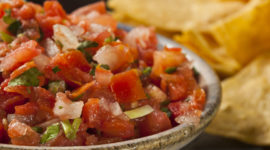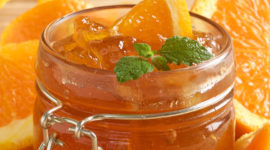Jam Session
Homemade jam you say? What a far fetched idea. With the hundreds of varieties available in the supermarket, why bother? Well, read the labels of those jars in the supermarket. You’ll find they contain many additives, artificial flavors and sweeteners. Your homemade jam contains nothing but fresh fruit and sugar and the occasional squirt of lemon juice. With the growing movement these days of knowing more about where your food comes from and what it contains, this is the perfect time to experiment with your very own homemade jams. In this column, we will concentrate only on jam, the definition of which is crushed fruit and sugar. Preserves are made from whole fruit or large pieces of fruit distributed throughout a thick syrup. Jellies are prepared from fruit juice and sugar, sometimes adding pectin to cause the jelly to set firmly. Marmalades are usually made from citrus fruit and include the rinds suspended in a jelly-like consistency.
We started making our own jams and marmalades many years ago. It is a great rainy afternoon project and the results are very satisfying. We make them not just for our own use, but also for lovely Christmas baskets, teacher gifts, hostess gifts, and thank you gifts. They are always received with great appreciation and amazement that there are still people in the world who make their own jam.
At this time of year with the bounty of fresh berries and fruits coming into season, delicious jams can’t be far behind. The following recipe yields about 4 pint jars. You will eventually get a feel for how much quantity of fruit you will need, but we will start small here. The formula is the same for small and large batches.
First of all, you will need a large, heavy pot, at least 10 quart capacity (non-stick is even better). Also, a candy thermometer which is different from a meat thermometer as it registers much higher temperatures. We usually use pint jars, but if you want the batch to go further, you can use half-pints. The jars come with lids and rings for sealing. The half pint size is especially nice for gifts. A wide mouth funnel helps when filling the jars with very hot jam.
Below is the basic recipe for any berry jam:
print menuIngredients
4 quarts firm-ripe berries (strawberries, blueberries, raspberries, blackberries) stemmed or hulled, washed and drained well.
Sugar
1 or 2 tbsp fresh lemon juice
Instructions
1. Mash the berries with a potato masher and measure. For every one cup of berries you will need 3/4 cup sugar. The dash of lemon juice sharpens the flavor of the jam and brightens the color of red berries. You can also make a mixture of berries for an end of the season delight.
2. Place the berries, lemon juice and sugar in very large, heavy pot and bring mixture to a boil, stirring until sugar completely dissolves. Boil, uncovered on low to medium heat, stirring occasionally until thick and the candy thermometer registers 218 to 220 F.
3. To test the jam for doneness, take a little of the hot mixture on a metal spoon, cool slightly and tilt the spoon. If the drops slide together in a single jelly-like sheet, the jam is done. Be patient, as reaching the final temperature can take a while. There may be a little trial and error here, but the worst that can happen is that the jam does not jell and you can just re-boil to take out more liquid. Or you can use the thinner liquid as a wonderful ice cream topping!
4. Meantime, your jars should be squeaky clean, which can be accomplished in the dishwasher. The seals and rings should also be clean and can be sterilized by immersing in boiling water for a few minutes or also run through the dishwasher.
5. Fill the clean jars with the jam to about 1/4″ from the top. Seal the tops and let cool. You should hear little “pops” as the jars form their seal. These can be stored indefinitely in a dark, dry place. Enjoy the “fruits” of your labor on your favorite breads and muffins, or as a topping for ice cream, angel food cake or cheesecake.


